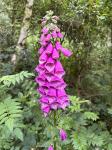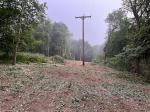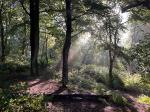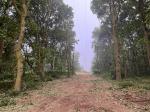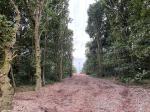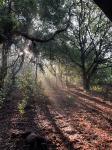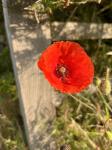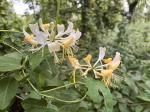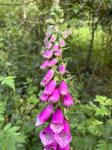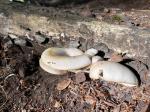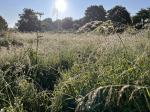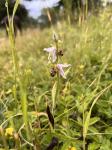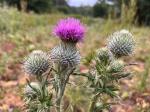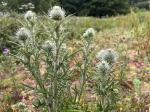Brayton Barff Through the Seasons.
Set in the Vale of York, South West of the market town of Selby and between the villages of Thorpe Willoughby and Brayton, lies Brayton Barff, a sandstone Hill approximately one hundred and fifty feet in height which was formed by glacial movement during the last Ice Age. It is a significant landmark in an otherwise flat landscape.
Today the site is primarily owned by Yorkshire Water with Selby District Council owning a small patch of the land adjacent to the A63 Selby bypass. A large underground reservoir occupies the centre of the site which delivers water to around 4.7 million customers throughout Yorkshire.
Within the Barff woodland over 40% of the trees are Sessile Oak which are generally found in semi natural woodlands in the north of the country. These trees are so called because its acorns are not held on stalks, like those of the English Oak (Pedunculate), but attached directly to the outer twigs. There are also several English Oak trees as well as some cross-hybrid oaks. These trees are known to support many species of flora and fauna, invertebrates, mosses, lichen and fungi.
During the Victorian times it is thought that the shipbuilders on the east coast would come over to the Barff for selected cuts of timber to build their sea going vessels.
The Barff also has a variety of other trees including Silver Birch, Beech, Sycamore, Holly, Rowan, Scots Pine, Alder, Hawthorne and European Larch. There are also several Yew, Willow, Hazel, Horse Chestnut and Wych Elm. As with similar woodlands there are a variety of bushes, including Honeysuckle, Elderberry, Gorse, Broom and Buddleia.
The history of Brayton Barff is quite vague, apparently during 1803 a beacon was lit on the Barff when the country was threatened with an invasion by Napoleon. In May 1935, to celebrate King George V's Silver Jubilee, a Bonfire was lit on the Barff as part of the celebrations.
Early issues of Ordnance Survey Maps dated 1903 clearly show a rifle range on the Barff, extending out to Mill Lane. During the 
Between 2001 – 2004 the A63 Selby bypass, 10km twin lane single carriageway was constructed which severed the South West corner of the Barff, adjacent to Selby Golf Course and resulted in a slight redesign of several holes on the golf course. Wooden fencing was erected as a result of this new road running alongside of the Barff and a footbridge constructed over the ‘new road’ following the line of the Bridal way which extends from Mill Lane. Around 2005/2006 a definite 2metre wide limestone aggregate footpath was laid forming a circular path around the outer edges of the woodland. This footpath is approximately 1.2 miles in length and takes about 30 minutes to circumnavigate at a leisurely pace.
In 2012 the Barff was declared an Ancient Oak Woodland and as such throughout 2012 and 2013 significant work had been carried out by the relevant agencies to cut and remove large swathes of non-native trees, creating at that time huge scars on the landscape. Some three years later the planting of the native trees have become well established and are flourishing. Ongoing maintenance work on the footpath around the bottom of the Barff was completed during the Summer of 2016.
A second phase of woodland maintenance commenced during the Autumn of 2019 with the removal of many old and diseased trees and the cutting back of the Gorse and Broom bushes, especially adjacent to the ‘bypass trail’, this work continued through till March 2020 with re planting continuing into April 2020.
Brayton Barff is a popular site for walkers and bird watchers alike and a path circling the outer perimeter of the Barff makes a pleasant thirty minute walk, giving views looking over towards Selby and the village of Brayton as well as the power stations of Drax and Eggborough..jpg)
For the early risers it is a great place to see some stunning sunrises over the villages of Brayton looking towards Drax Power Station, the same with the Sunsets looking over towards Eggborough and Monk Fryston.
The Barff changes with the Seasons and every visit can reveal something new, the woodland is a haven for wildlife. Records show that since 1982 one hundred and twelve species of bird have been seen in the woodland and at least 40 of those have bred here, including Tawny Owl, Buzzard, Green Woodpecker, Spotted Flycatcher, Goldcrest and Nuthatch to name just a few. On average over 70 species of bird are recorded each year. Further details of the bird life on the Barff can be found on the Brayton Barff Group Facebook page, especially the posts from Derek Cooper. Today ‘The Friends of Brayton Barff group’ led by Derek and a small team of volunteers help keep and maintain the cleanliness of the site as well as recording the wildlife and bird sightings.
The Barff is also home to fifteen different species of mammals, including Muntjac Deer, Pipistrelle Bat, Fox, and Field Vole.
Over eighty species of plant and wildflowers have been recorded, included Bee Orchid, Northern Marsh Orchid, Wood Anemone, Marsh Ragwort, Bluebell, White Bluebell, Bittersweet and Purple and White Foxgloves. Over twenty species of Butterfly have been recorded, including Marbled White, Brown Angus, Speckled Wood, Comma and Brimstone.
During the Autumnal months fungi thrives in this woodland environment, species including Fly Agaric, Beefsteak Tree Fungi, Chicken of the Wood, Sulphur Tufts, Stinkhorn, Ink cap, Puffballs and Hoof Bracket are just some of the many varieties that can be found here.
Click on the galleries shown below to expand the albums.
June 2023
After several weeks it was good to see that Yorkshire water has finally managed to cap the water leak that was cascading over the perimeter footpath.
Yorkshire Water has been quite proactive in clearing a lot of the foliage under the overhead cables, a job that has needed doing for some time. Heavy machinery was brought in on Wednesday 14th June, when the Barff was closed to the public for the day to clear some of the bigger trees and bushes. The clearance has made quite an impact on the landscape around the Barff. I wonder when they will return and clear the Bridal footpath which forms part of the Selby Horseshoe walk. The trails on both side of the bypass are now heavily overgrown with invading Bramble and Blackthorn bushes and barely wide enough for one person to walk along, I certainly wouldn’t lead my horses down them.
Early in the month the sweet scent of Honeysuckle was filling the air, especially around the top of Tap Hill and occasionally around the perimeter footpath.
I have seen several dead voles recently on the smaller trails around the woodland, there was no sign of disease or injury on them and when I returned later in the day, they had disappeared presumed predated.
The Oil seed rape has finally finished flowering, it seems to have been in flower for ages, and started to turn to seed, it will be around another six weeks or so before it is ready for harvesting, weather permitting.
Since returning from holidays it has been exceptionally warm on the Barff, morning air temperatures at 6.00am averaging at 14c mid-afternoon temperatures 25C. As a consequence to the warmer and humid weather the undergrowth is exceptionally lush and green, nettles appear to be growing at an alarming rate, in places they are over five feet tall, and can give a nasty irritating sting on your arms and legs, I have never known Bramble runners grow as fast as they are at the moment, they too can give you a nasty scratch on your arms and legs. Ferns are flourishing too, they have even started shooting up on the ground just recently cleared by YW.
Although we have had several yellow weather warnings for thunderstorms this month, we have got away quite lightly, the rain that fell at times was heavy, mainly in the afternoon or evening, but only short lived and within several minutes the road and paths would be dry again. It has been exceptionally muggy with early morning temperatures (around 6.00am) varying between 12C – 18C.
This June looks to be heading for the hottest on record according to the Met office. The next few cooler days will not be enough to prevent June 2023 from exceeding the previous mean average record of 14.9c set in both 1940 and 1976. The Met office has not recorded a June this hot since it began collecting temperature data in 1884. What has been particularly unusual is the persistent warmth for much of the month, with temperatures reaching 25C widely for at least a fortnight and at times 28C – 30C, whereas we would more typically expect maximum temperatures in the high teens or low 20’s at this time of year.
Bird song around the Barff seems to be as strong as ever, I am frequently hearing Chiffchaff, Blackcap, Song Thrush, Garden Warbler, Wren, Goldcrest and Mistle Thrush, most often on top of the Barff.
|


